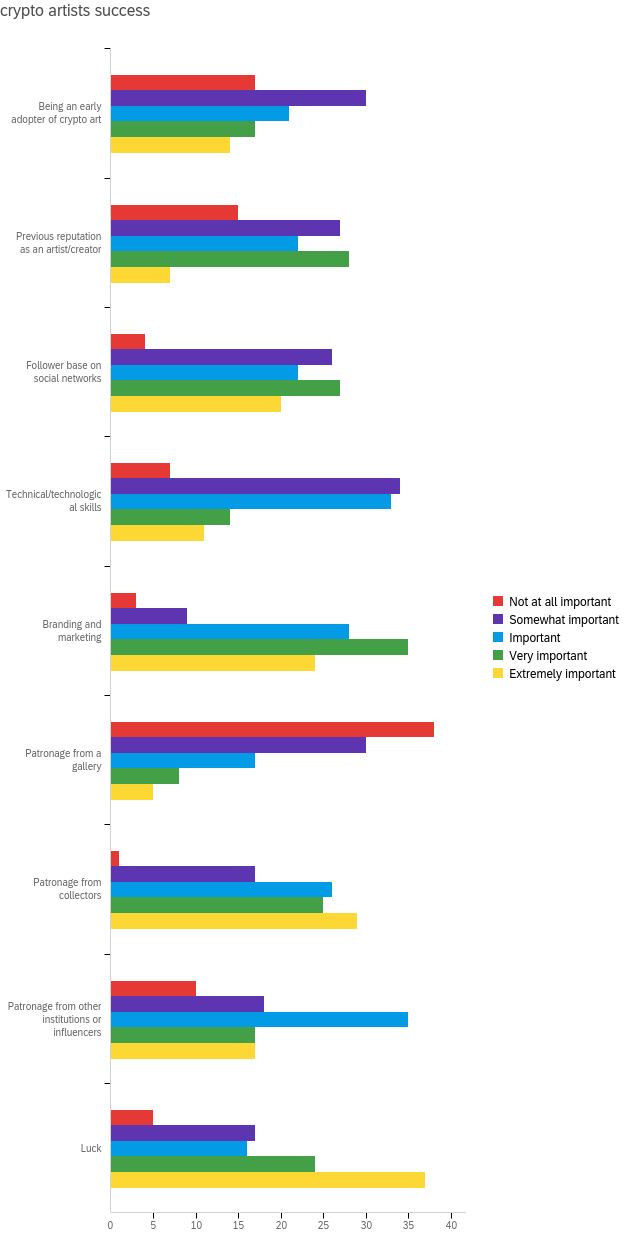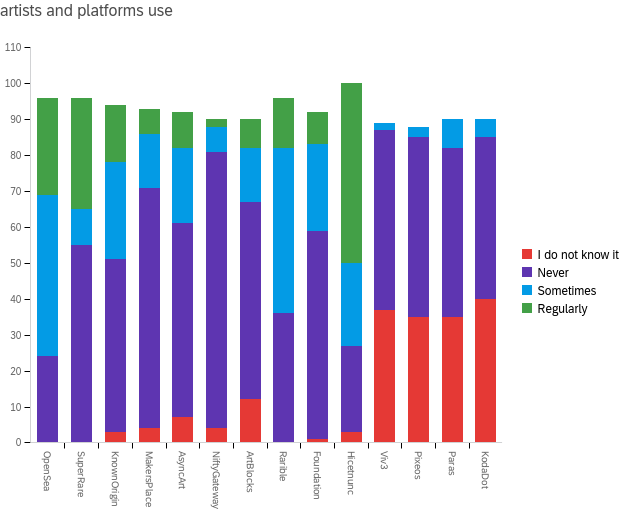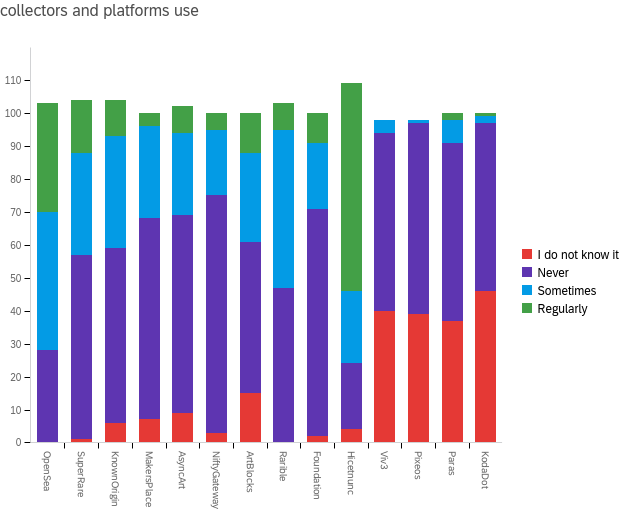
The Crypto Art Market between Artists and Collectors
The Crypto Art Market between Artists and Collectors
To study the phenomenon of crypto art in relation to traditional art categories and economic value creation and distribution, in mid-June 2021 our team released the first large-scale survey on the subject, open to the crypto community. As highlighted in our first blog post on the project, over the past months, the survey was taken by approximately two-hundred people, about half of which replied to all questions. To give context to our sample one can consider the number of unique wallets that bought and sold at least one crypto artwork over these years, which is over 7,000 according to one of the earliest NFT market data resources, mapping the space since 2018 and currently monitoring over 30 major crypto art projects and platforms. Despite the limited size of the sample and the short time frame of this study, conducted last summer, it provides a benchmark for future investigations.
Analysing the survey results, this time our team focused on the roles of crypto artists and collectors, their platform usage and recent market activity, and the following key facts emerged:
- Crypto artists are also crypto art collectors, and they focus on crypto art’s aesthetic value;
- Gallery representation is not deemed essential for crypto artists’ success;
- OpenSea is the leading platform for creating and buying NFTs, providing a vast marketplace for crypto art along with collectibles;
- Although crypto art lives mostly on the Ethereum blockchain, the platform Hic et Nunc, built on Tezos, was on the rise before experiencing discontinuity.
In general, according to survey participants, most crypto art users hold a bachelor’s or master’s degree. Reading these results in conjunction with users’ age range, it is likely that some of them are still studying. As for artistic training and education in particular, the results are split almost evenly, with 46 people having some level of art education and 54 with no art background. In the first group, most people still did not attain any art degree, followed by those who hold a Master of Fine Arts and those with a related bachelor.
Whether academically or self-trained, experienced or just self-proclaimed, let’s focus on artists.
Crypto Artists
According to the survey participants, education or technical and technological skills are not deemed the main advantages when it comes to crypto artists’ success. In fact, the 99 replies collected on the topic suggest that the main ingredient is luck, deemed extremely important by 37% of participants. Luck is, however, closely followed by patronage from collectors and self-branding. In this dense ecosystem, a good follower base is deemed relevant, too. Having a previous reputation as an artist is valued more than being an early adopter or being skilled, while most artists (70%) agree on the lack of importance of gallery’s patronage in the crypto art domain and market. In this context, the fact that galleries and platforms are not deemed of great impact might signal that they appear as gatekeepers to some, somewhat in contrast with the community’s decentralized spirit. This is particularly relevant if we think about the access barriers that the traditional art market poses in terms of gallery representation, essential for artists to participate in art fairs, for instance.

Access to the right opportunities, marketing and branding seem essential for crypto artists to succeed. Collectors play a prominent role too, but, as in the traditional art market, it seems that success mostly follows an artist’s name. Crypto artists that are able to build a strong follower base on social media and secure a strategic network that supports and acquire their work will break through.
When asked what they find most valuable in crypto art, the 103 artists who replied responded with the order of aesthetic value (100%), followed by societal (72%) and economic value (68%).
Looking at the market from a crypto artist’s perspective, we see that 92 of them sold artworks over the spring or summer period, predominantly on the primary market, while only 12 did not; only 11% were equally active on the primary and secondary market.
Regarding platforms, we notice that those known to almost all the crypto artists that took part in the survey are OpenSea, SuperRare, Rarible and Foundation. Fairly under the radar in terms of being known and used are Viv3, Pixeos, Paras and KodaDot, operating on the Flow, Near and Kusama blockchains. As expected, crypto art typically lives on the Ethereum blockchain. An interesting exception is made by Hic et Nunc, built on Tezos, which appears to be used on a regular basis by 50% of the 95 artists that replied, followed by SuperRare (33%) and OpenSea (27%).
OpenSea has a high score among the platforms artists use only sometimes, together with Rarible (both 48%), KnownOrigin (29%), Foundation (26%) and Async (22%).
Apparently never used but at least known to most are NiftyGateway (85%), MakersPlace (71%) and Foundation (64%), closely followed by ArtBlocks (61%), AsyncArt (59%), SuperRare (57%) and KnownOrigin (50%).

Given that except for Hic et Nunc, OpenSea and Rarible all platforms are invite-only or curated platforms, the usage results seem to align with accessibility barriers. Focusing on the most known and used platforms, OpenSea was launched in December 2017 and Rarible in October 2019, while Hic et Nunc only turned to crypto art in February 2021. Given its recent creation, apparently this platform was on the rise among creators at the time of the survey.
Crypto Collectors
Crypto art platforms have no restrictions for collectors, who can easily connect their digital wallets and build their collection, with the only limitation of their own taste and budget.
In general, the selection provided by the 100 collectors that replied reflect the artists’ results regarding the most known and unknown platforms in the space, the former being OpenSea, SuperRare, Rarible, and Foundation and the latter being Viv3, Pixeos, Paras, and KodaDot.

Looking at platform usage, nearly 60% of collectors made regular visits on Hic et Nunc, outperforming artists’ results; OpenSea was selected by 31%, used nearly as frequently as by artists, while SuperRare got 15%; these are followed by ArtBlocks and KnownOrigin. Rarible leads among the platforms used only sometimes, with 45% of votes, followed again by OpenSea (40%), KnownOrigin (32%), SuperRare and MakersPlace (both about 27%).
Apparently never used but at least known to most are NiftyGateway (74%, a lower percentage compared to artists’ results), Foundation (72%), MakersPlace (62%), which is closely followed by AsyncArt (60%), then SuperRare (57%) and KnownOrigin (51%).
Regarding market activity in the spring or summer period, 95% of collectors made at least one purchase. Of them, 82% were active on the primary market and 17% equally on the primary and secondary market, signalling that crypto art and NFTs were in demand.
Comparing the value artists’ and collectors’ give to crypto art, we witness a higher neutrality among the latter, but aesthetic value seems to be deemed essential again. It totals nearly 90% of positive votes over 112 replies, followed by societal (49%) and economic value (42%).
A Comparison
Considering both artists’ and collectors’ usage percentages, it appears that most survey participants both make and buy crypto art, valuing its aesthetic qualities first and foremost. Looking at the best-performing platforms, one can notice that they provide unrestricted access to artists. Among the crypto artworks issued on Rarible and Hic et Nunc one can probably find some affordable options – this is particularly true considering the USD equivalent of Tezos for Hic et Nunc, which is not as expansive a cryptocurrency as Ether, for instance. OpenSea represents the major platform where to buy or list NFTs on the secondary market, which might clarify its wide use. In particular, OpenSea also provides a wider marketplace for collectibles, which might be of interest to some collectors.
NiftyGateway is renowned for hosting the works of blue-chip creatives and branding itself as an exclusive and costly marketplace instead, hence its low percentage of active collectors. Somewhat surprising are the results of Foundation and MakersPlace, the latter being the less regularly used of all galleries despite its longevity.
As well as by artists, Hic et Nunc is known and used by collectors too, despite the platform experiencing a discontinuity in November 2021.


